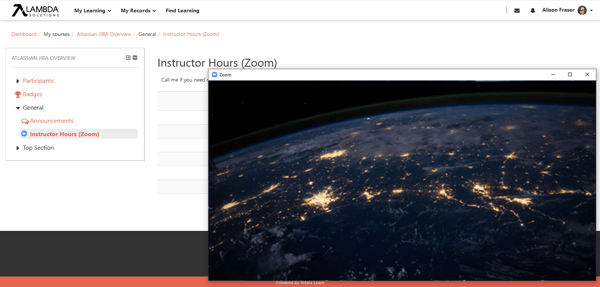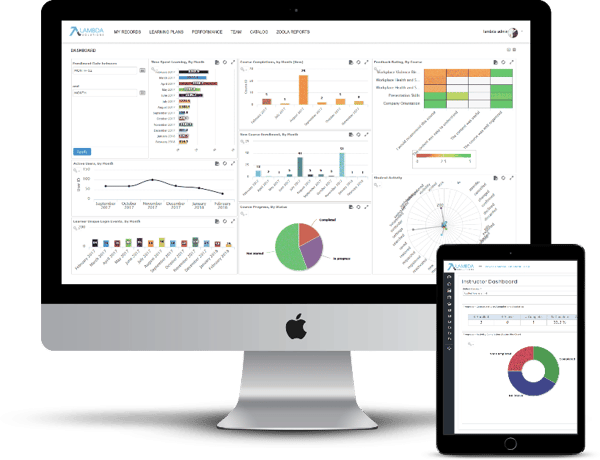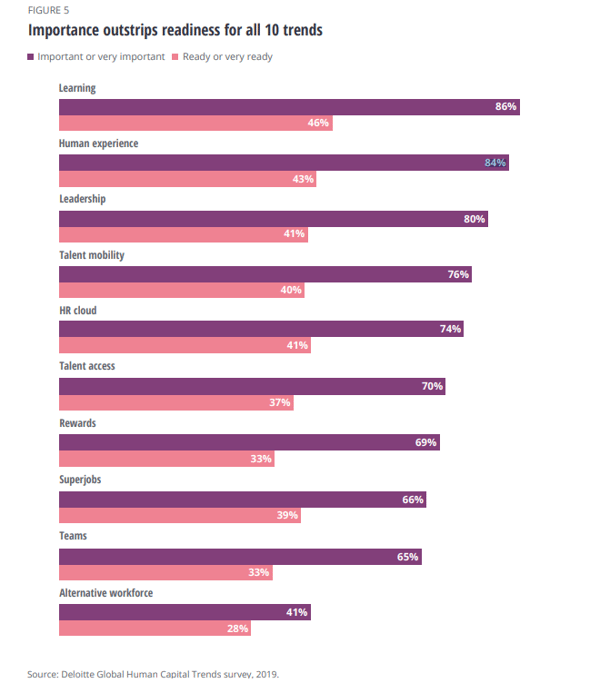Our eLearning experts weigh in and analyze 2020’s unprecedented impact on eLearning industry trends in 2020 so that you can take full advantage of new and expanding opportunities.
The eLearning industry at a glance…
It’s without a doubt that the entire world has been affected by the pandemic in some way or form. Organizations have had to cope with changes in the environment physically and technologically being forced to dive into alternative ways to adjust.
For the eLearning industry it's no different. It is estimated that the closures of schools have affected about 70% of the total student population worldwide (UNESCO). That's roughly 186 countries and about 1.2 billion students since April 2020!
Though the education industry has been affected, this hasn’t stopped learning in its tracks. And not only for children but adults and professionals as well.
 As a lucrative industry on the rise, the opportunity to take advantage could not have come at a better time. Because eLearning is not going away anytime soon!
As a lucrative industry on the rise, the opportunity to take advantage could not have come at a better time. Because eLearning is not going away anytime soon!
According to industry reports, “The global market for e-Learning is projected to reach US$305.3 billion by 2025”.
And with a forecasted 7.8% potential growth in the academic sector it's not stopping anytime soon.
Demand for eLearning solutions is drastically increasing as the flexibility, convenience, and versatility have become a dire need as shifting online becomes essential.
eLearning is now being adopted into various other industries within the corporate sector such as financial services, retail, healthcare, manufacturing, telecommunications and much (shown in the graph below).
Due to the pandemic, and the ubiquity of the internet, technological innovations have essentially been pushed forward. This push coincides with the current technological environment within the industry developments of digital mediums such as immersive learning and mobile learning and gamification etc.
Adapting To The Realities Of Coronavirus & COVID-19
The 2020 pandemic has caused major disruption across the world. Industries have either had to adopt or adjust their strategies in the way they deliver their learning and development. Ultimately there was no real alternative for anyone in these circumstances; especially for Allen Koh, CEO of Cardinal Education, who confirmed:
“It is in this backdrop that we try to understand the social-emotional well-being of both teachers and students alike. Learning to adapt to an online environment has been very stressful for both - most particularly to teachers as they are the ones subjected to the demands of “reimagining” the way they prepare their syllabi and facilitate their lessons. Teachers are finding creative ways to engage their students and ensure that learnings are retained. For the students, they are learning and mastering the LMS (learning management system), and are motivating themselves to focus given the surrounding distractions of an online learning set up…”
Regardless of the current times, the eLearning trends have been around to support learning endeavors across multiple industries. Whether adopting or or progressing there are mediums that can suit the needs of any organization. Listed are some that are that are currently dominating the industry today!
What Online Learning Trends Are Growing Now?
As the market expands along with the efficiency of cloud-based technology, organizations are jumping onto the eLearning movement through progressive monetary investments that will drive a demand for more digital services, videos, conference tools and much more.
Through the support of solutions such as Massive Open Online Courses (MOOCS) and Learning Management Systems (LMS) you can administer these mediums, track them and be able to create better more effective programs. But first we will examine the trends before the technology.
Immersive Virtual & Augmented Reality Training Trends
You know when education has reached the “next level” when you take traditional blackboard learning and digitally immersing the user into the industry's environment.
Because, why not throw your learners right into the work environment?
Immersive learning provides an outlet for interactive self-guidance and is a logical way to amp up learner engagement.
As user generated content increases along with the improvements in technology this medium will likely continue to be a growing trend. Especially with its easy integration and usability with learning techniques such as microlearning and gamification.
But first let's get “real”.
These forms of immersion are Augmented Reality or Mixed Reality (AR or MR) which involves interacting with physical or tangible objects. Enabling the user to work with digital objects versus physical ones is not only ideal and time saving but cost effective as well.
The experience can expand a user's depth in reading, spatial concepts, math, social skills and real life scenarios.
While figures for the eLearning-specific augmented reality market are hard to come by, the market for the technology overall was $10.7 billion USD in 2019 with an estimated 46.6% annual growth rate until 2024, as discussed in this eBook on the eLearning Industry.
In addition Virtual Reality (VR) is designed to allow the environment to feel real. Examples for using VR training would be in healthcare where learners are guided through medical procedures or safety and compliance for the mining industry.
Simulation is already highly popular in gaming with first person (point of view) capabilities, so though it's been around for a few years it will continue to be a growing trend.
Immersive technologies continued to have their place within the learning industry, however it’s still development and due to its current high price point and usability. This is predicted to eventually drop in the future due to more efficient software improvements.
The VR market is estimated to be worth "60 million USD in 2018, with a compound annual growth rate projected at 42.9% for the next eight years".
Example of game simulation from Star Wars Vader Immortal VR for Oculus*
Microlearning: Fun, engaging, effective, and bite-sized
Microlearning helps deliver information in shortened chunks allowing for better content absorption. This is great for capturing attention within today’s fast-paced environment where the need for longer attention spans is diminishing.
This method can provide better focus and improved learning transfer becomes manageable especially with larger curriculums.
For example a 2 hour course can be broken up into 4, 30 minute sessions. Predicted to work well together, the future of microlearning is a highly anticipated one especially with the growth of immersive learning.
Micro learning is a BIG topic with lot’s to explore. If you want to learn more, this article has what you’re looking for: Microlearning: What, Why, How, Where, and When?
With Gamification engagement and retention can be effective especially when delivered in a fun positive manner.
The perceived novelty of “gaming” can allow a learner to have full control over their level of competence and autonomy, while providing immediate learning feedback. The concept reinforces the “freedom to fail” enabling a user to find alternative ways for users to problem solve.
Through taking “constructive” risks you can foster a growth mindset and create realistic expectations. Furthermore points systems, badges and stats can drive intrinsic motivation, the feeling of accomplishment, to drive continuous improvement.
For a deeper dive into the benefits (and how to bring them to your learners) you need to read this article explaining: Gamification & Interactivity: The Engagement Formula Your eLearning Needs
Video-Based Learning Reigns Supreme
Video-based learning is likely the most popular and used medium today and for good reasons!
Video is flexible, as it can be used for many different role functions such as training videos, classroom lectures, human interest stories and more.
As a suitable medium for stand-alone or as a cohesive program, learning can be presented informally or formally depending on the audience. And in today's technological environment video learning will not phase out anytime soon.
Due to its multi-purpose nature video can provide a more engaging experience not only in regards to learning and development but even for branding purposes as well.
 Zoom video conferencing integration is simple in the Lambda Suite.
Zoom video conferencing integration is simple in the Lambda Suite.
Want engaging video content but don't know where to start? Here's some of our own video-based learning that'll get you where you need to be: Creating Effective Learning Videos in 7 Easy Steps.
mLearning: Mobile Learning Puts The Power In Your Hands (Literally)
Mobile learning is slated to be dominant in online learning delivery, according to industry analysis: “The Global Growth Of The Mobile Learning Market Is Expected To Be Worth $37 Billion By 2020.”
The whole world is on smartphones! Currently, we are in a time where accommodating mobile capabilities is a must for any organization.
All smartphones have multimedia capabilities which make for a perfect opportunity for L&D departments to take advantage. It provides ease of collaborative social via online forums, FTPs, chat rooms and support on real-time conversations.
Mobile can be perfect for microlearning, video, immersive or personalized content that can be self-directed. Though mobile capabilities are still being adopted and improved through new innovations, you can definitely feel its presence!
Also with the lower costs, quick implementation and updating eventually adapting to mobile will provide immense benefits throughout a gamut of industries.
Every individual has a different learning style, so finding the best approach to implement your content is a constant challenge. Analytics can provide the right insights into considerations based on your business objectives, or goals.
Big Data in the form of learner analytics can play a huge role in benefiting your future training endeavours. With the data accumulated through your L&D solution, organizations can help make qualitative and quantitative decisions.
This is practical and convenient as analytics continues to be incorporated into business intelligence to measure and achieve return on investments, find job candidates and understand what skillsets are suitable for job roles.
Knowing what exactly an employee needs for training can save time and money. Through analytics, organizations are also able to create bigger and better innovations for technological advancement.
Discover exactly how your organization can use big data and analytics to optimize, improve, and prove the impact of your eLearning in this free eBook: LMS 101: Learning Analytics
Current Content Providers
There are essentially two ways to approach the administering of eLearning content: You can create the content for clients to utilize on their own learning solution, with Massive Open Online Courses (MOOC)s, or you can provide courses to end-users using your own Learning Management System (LMS).
There is also a split in the market between systems targeted towards the Education and Corporate sectors, as the features and requirements for each can be very different. Let’s explore!
Learning Management System (LMS)
“The global learning management system (LMS) market size was USD 8.76 billion in 2019 and is projected to reach USD 38.10 billion by 2027, exhibiting a CAGR of 19.7% during the forecast period”.
Learning management systems serve as a platform for delivering, administrating, and documenting online courses, professional training, and learning and development programs.
Generally Learning Management Systems are used by organizations internally for Learning & Development initiatives, such as onboarding, accreditation/compliance, and competency training. However, training and eLearning businesses can utilize an LMS to deliver online courses on almost any topic directly to the public.
Because an LMS can be configured to match an organization's structures and hierarchies, it can be a dream solution for many HR and L&D Managers.
See first hand Why You Should Be Running Your L&D Team Like A Startup in this free webinar from out eLearning experts.
The opportunities for learning pathways can benefit those who utilize an LMS’s capabilities. Depending on the learner and flexibility of the solution, a learner can be presented with a plethora of mediums that can support their training in the most effective way possible.
This could include immersive learning or any of the up and coming learning styles mentioned above as means of improving training outcomes (and long-term performance, the end goal of most L&D programs).
For step-by-step guidelines and best-practices to follow, take home our eBook on how to Attract Star Talent and Keep Them! Learning Paths for Employee Retention.
Taking advantage of the LMS’s internal analytics functionality which gives data-based insights for creating more effective content in the future.
 An example of dashboards for learning evaluation from Lambda Analytics.
An example of dashboards for learning evaluation from Lambda Analytics.
All these aspects correlate to promoting better engagement that gives the user a more meaningful experience. Demographics that use LMS’s are typically students in educational institutions, corporate, HR professionals, and governments.
Massive Open Online Courses (MOOCS)
“Massive Open Online Course (MOOC) Market is expected to register a healthy compound annual growth rate (CAGR) of over 29% during the forecast period (2019 - 2024).”
Formatted to be offered as stand-alone single courses, MOOCs are readily available eLearning content. Flexible and with no time restrictions, courses can easily be updated based on changing environments and best practices.
Originally started in Harvard and MIT they were designed as a solution to the challenges of distance education.
Publicly available as a business to consumer (B2C) product, MOOCs tend to be used by the “lifelong” learners who aren’t necessarily enrolled in institutions but are looking to enrich their lives.
With its dominance in North America, these courses are expanding into developing countries creating opportunities for growth.
Reasons for the expansion are due to its low-to-no price points, in tandem with the current unprecedented times, which for many has created a great opportunity to learn (even on a budget).
However there is a decline in growth due to and limitations to the number of enrollments within a course at a time. Due to these types of characteristics, a MOOC acts similarly to a proprietary system. In addition to decline, other issues include its non-profit nature, high cost implementation and lack of credential.
Forecasted eLearning Trends

There’s no doubt that online education is going through continuous changes and innovations. Especially with the current environment, technology will open doors for new competition and greater opportunities for growth within the industry.
There could be a no better time to hone in on the lucrative eLearning industry that can provide a more meaningful experience as the world now sits behind screens with limited social interactions. Listed below are some of the eLearning trends to look out for:
Learning Experience Platforms (LXPs)
One of the big up and comers where artificial intelligence (AI) is leveraged and integrated within the user’s learning paths. Through this technology the AI understands the learner and can therefore create recommendations for a user to progressively self direct themselves.
The format of LXPs have been compared to a “content provider” such as Netflix where algorithms dictate the next steps in a learning pathway.

A key feature is their ability to integrate well with various multimedia channels such as podcasts, videos and more, that can be facilitated through various styles such as microlearning. LXPs are meant to be fun and engaging while at the same time relevant to a user's success.
Features such as social collaboration and program achievements are recognized through certificates and badges. Furthermore the option for user-generated content is inclusive for those who are interested in offering their niche expertise.
xMOOCs
The MOOC trend is also growing with continuous financial support from investors as competition rises. xMOOCs are courses that are owned and specifically for profit with two key players such as edX, Udemy and Coursera.
As xMOOCs expand and become more accessible for example offering courses to contribute to a degree programs.
MOOCs will eventually meet industry requirements. Through its expansion into business and as more content develops this trend is predicted to eventually hold a more significant market.
Artificial Intelligence and Adaptive Learning

As this technology continues to develop its no doubt that this is one of the most highly anticipated eLearning methods. Through machine learning and adaptation, educational content will be tailored and generated through algorithms and assessments.
Techniques through guidance and chatbots, such as for example Siri or Microcoft’s Cortana, will help users to carve out learning paths with data assessments.
These assessments are meant to address the needs of individuals with recommendations for improvement as a means for increasing interactivity and personalization.
How eLearning Will Affect The Corporate World
 eLearning can benefit not only the education industry but the corporate world as well. According to a study by Brandon Hall Group, eLearning takes 40% to 60% less employee time compared to traditional learning (Forbes, 2017).
eLearning can benefit not only the education industry but the corporate world as well. According to a study by Brandon Hall Group, eLearning takes 40% to 60% less employee time compared to traditional learning (Forbes, 2017).
Plus 90% of organizations are using eLearning now more than ever since 4% in 1995, according to KPMG.
Due to its feasibility corporations are on track to contributing to the industry's growth for the next decade.
Millennials make up the majority of the world's workforce and meeting the demands of this generation poses a challenge. It states that 86% of the next generation in the workforce links opportunities for continuous improvement to employee satisfaction.
This can involve promoting engagement and other means of development which is important to consider when good candidates are scarce.
What did we learn?
Throughout this article we’ve learned how the elearning industry advanced very quickly with the demands for learning solutions since the advent of the pandemic. But through research and statistics we noticed that the industry was not only growing but adapting to the environmental changes regardless! It's already present with its existing and anticipated innovative trends.
On an endnote, as we progress into the new year, we will see eLearning solutions providing ongoing support for organizations resulting in an inevitable increase in market share and competition.
Looking for more? Our eLearning industry experts have put together everything below to offer you more advice, best-practices, and how-to guides for growing your revenue, ROI, and growing your learning business:
- eBook: What is an eLearning Business? Examining the $200-billion eLearning Industry
- eBook: Solving The Biggest eLearning ROI Challenges
- eBook: Onboarding Best Practices for Maximum ROI
- WhitePaper: Assessing the ROI of a LMS:
- Webinar: Everything You Need to Build Your eLearning Business
- Article: The Biggest Education Technology Trends



